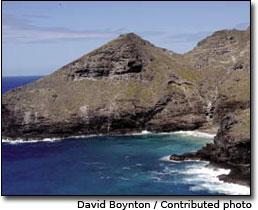Keiko Cecilia Bonk, a former chairman of the Hawai’i County Council, joined forces with Kaua’i County Councilwoman JoAnn Yukimura in pushing through a council resolution to protect the North-western Hawaiian Islands. The resolution, which was approved by members of the
Keiko Cecilia Bonk, a former chairman of the Hawai’i County Council, joined forces with Kaua’i County Councilwoman JoAnn Yukimura in pushing through a council resolution to protect the North-western Hawaiian Islands.
The resolution, which was approved by members of the council during their recent meeting at the historic County Building, asks Gov. Linda Lingle, national political leaders, members of leading environmental groups like Hawaii Audubon Society and a leading Hawaiian group, KAHEA, to protect the remote archipelago.
The chain is home to endangered and threatened marine species, coral kingdoms, and millions of migratory seabirds.
The chain is said to hold great historical and cultural significance to Hawaiians, as it was featured in the ancient Hawaiian ‘oli (chant) and mele (song), according to Yukimura’s resolution.
The island chain, which encompasses the island of Nihoa, located northwest of Kaua’i, through and including Kure Atoll, stretches for more than 1,200 square miles. The chain is almost entirely uninhabited.
Bonk served on the council of Hawai’i County in 1992, and as its chairman from 1995 to 1996.
Identifying herself now as a Northwestern Hawaiian Islands coordinator for the Hawaii Audubon Society, Bonk told the Kaua’i legislators that the Northwestern Hawaiian Islands is “truly Hawai’i’s state treasure,” and thanked Yukimura for proposing the resolution.
If protected, the chain would be the only “world heritage (UNESCO) site that has both cultural resources as well as natural resources,” Bonk said.
The United Nations Educational, Scientific and Cultural Organization (UNESCO) was founded in 1945, and has evolved as a specialized United Nations agency.
Today, UNESCO leaders provide the arena for the exchange of ideas internationally, and the forging of agreements among nations in the world.
UNESCO officials have developed programs to manage the earth’s resources, and one of their priorities is the protection of the ocean and water ecosystems.
Efforts by the federal and state governments to protect the Northwestern Hawaiian Islands would be greatly enhanced and supported by the naming of the chain as a UNESCO site, Bonk contended.
“If we became this site, and we do continue to progress with our federal protection laws in the Northwestern Hawaiian Islands, we will have the bragging rights to be home to the largest reef refuge in the world,” Bonk said.
Marti Townsend of KAHEA, the Hawaiian Environmental Alliance, voiced similar sentiments, and noted that the waters around the chain amount to what is the last “predator-dominated eco-system in America.”
Townsend said that means the entire food chain around the archipelago is intact, making the area unique.
“All the way up the chain, from the smallest plankton, all the way up to the largest fish, the largest shark, (they) are intact,” Townsend said. “So the whole thing is totally functional, and needs to be preserved.”
Bonk distributed information indicating that the Northwestern Hawaiian Islands are home to more than 7,000 marine species, and includes the major foraging grounds of the Hawaiian monk seal, the most endangered marine mammal in the United States.
Only between 1,300 to 1,400 monk seals remain.
The chain also is home to the threatened Hawaiian green sea turtle. For the species, the French Frigate Shoals provide 90 percent of the nesting sites.
Geographically, the progression of the main Hawaiian Islands to the Northwestern Hawaiian Islands is the best worldwide example of sequential evolution of islands to atolls, according to literature Bonk distributed.
The council resolution, which is non-binding, has been sent to the Lingle, the Hawai’i congressional delegation, and officials with the National Oceanic and Atmospheric Administration, the U.S. Council on Environmental Quality, the Hawaii Audubon Society and KAHEA.
The council resolution marches in step with efforts by U.S. House Rep. Ed Case, D-Neighbor Islandsrural O’ahu, to protect the same site.
In May of this year, Case introduced the Northwestern Hawaiian Islands National Marine Refuge Act of 2005.
The measure, which is still pending in Congress, designates the chain and surrounding waters as a fully-protected, national-marine refuge.
Ho’ike Kaua’i Community Television, Inc. broadcasts this month (channel 52) feature a half-hour look at Case’s recent visit to the Northwestern Hawaiian Islands.
Lingle and Peter Young, chairman of the state Board of Land and Natural Resources, recently signed regulations that establish all state waters in the Northwestern Hawaiian Islands as a marine refuge.
Lingle described the rules as the most significant marine-conservation initiative in the history of Hawai’i, effectively creating the state’s largest marine refuge.
The rules protect all of the state waters from extractive uses, including commercial and recreational fishing. Entry permits are required for other activities along the archipelago.


